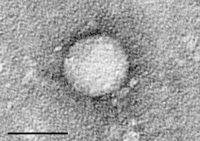
Photo from wikipedia
Background The introduction of highly potent direct-acting combination therapies for HCV have negated the role of response-guided therapy and reduced the role of treatment monitoring. However, there remains a need… Click to show full abstract
Background The introduction of highly potent direct-acting combination therapies for HCV have negated the role of response-guided therapy and reduced the role of treatment monitoring. However, there remains a need to identify patients who are actively infected with HCV and discriminate those who have achieved sustained virological response (SVR) from those who fail to achieve SVR. Methods A total of 1,678 plasma samples from the 631 subjects enrolled in AbbVie's SAPPHIRE I trial (NCT01716585) were tested in a blinded fashion with Abbott HCV core antigen (cAg) assay and results were compared with Roche High-Pure system/COBAS® TaqMan HCV RNA 2.0 assay. Results Using 10 fmol/l as the clinical cutoff for cAg, the HCV RNA and cAg tests were in 100% agreement for true negative samples and 99.6% agreement for truly positive samples. One discordant (screening) sample was identified. This sample was target not detected by HCV RNA method but positive by anti-HCV and highly positive by ARCHITECT core antigen (7,912 fmol/l). Seventeen samples had cAg levels in the ‘grey zone’ >3 but <10 fmol/l at initial testing and were re-tested per package insert. All of these samples gave a result of <3 fmol/l upon retest. These results were in alignment with target not detected HCV RNA result. One sample had a cAg >3 but <10 fmol/l when tested on three consecutive occasions (5.8, 5.5 and 4.4) but had a target not detected RNA result. Conclusions In this study cAg, with a 10 fmol/l cutoff, accurately identified 99.6% of patients with active viraemia and discriminated all subjects who achieved SVR from those who failed therapy.
Journal Title: Antiviral Therapy
Year Published: 2018
Link to full text (if available)
Share on Social Media: Sign Up to like & get
recommendations!